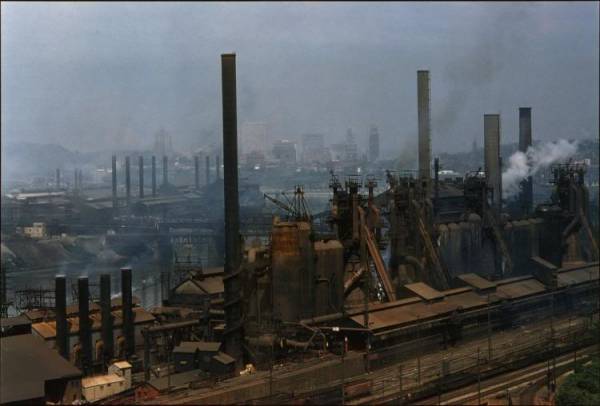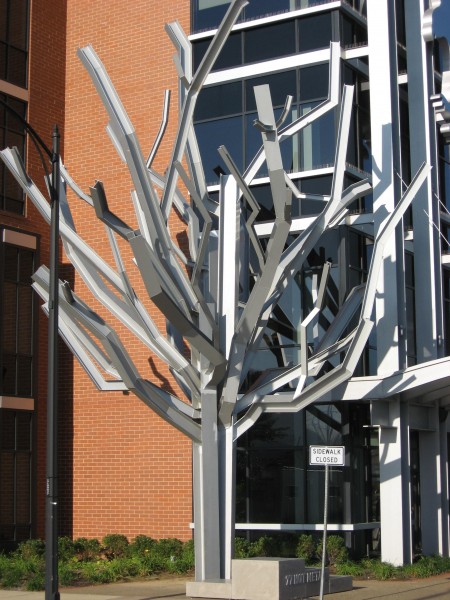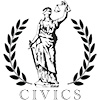| « March of the Morons: Brady on Evolution and Creation | Do Bike Lanes Make Bikers Less Safe? » |
Urban Planning Thu Oct 07 2010
A Steel Tree: Return to Pittsburgh
The corporate headquarters of American Eagle Outfitters, situated on the South Side of Pittsburgh, sits on what is known as the "Hot Metal Campus." Inside the building, a rush of attractive 20-somethings swiftly move about with a persistent soft buzz as jeans are shaped and cut, and merchandise is tested, worn, developed and discarded. The Hot Metal Campus rests along the Monongahela River, which is easily traversed by crossing over the Hot Metal Bridge towards the city's East End and its Downtown. Like most other sites along the river, gigantic steel mills once proudly stood here. In their time, the mills and refineries gave Pittsburgh its raison d'etre, coloring its skies in money and soot.
 The J&L Steel Mill, Pittsburgh, PA circa 1951.
The J&L Steel Mill, Pittsburgh, PA circa 1951.
The particular parcel where American Eagle now stands formerly belonged to Jones & Laughlin Steel, which in its heyday held 15,000 people in its employ at the SouthSide Works plant. The quiet hum that pervades the site now would almost seem to belie its history, but is in fact just as indicative of the Pittsburgh of today as J&L was of Pittsburgh's past. Flanking either side of AE's building stand two large steel trees. The sculptures, at once massive and intricate, display not only the story of the Hot Metal Campus, but also the continuing story of Pittsburgh itself.
 A Steel Tree outside of American Eagle Headquarters, Pittsburgh, PA circa 2010.
A Steel Tree outside of American Eagle Headquarters, Pittsburgh, PA circa 2010.
A few weeks ago, this space spilled some digital ink on the Pittsburgh "reinvention" story. The piece seemed to pick up on a meme floating around of Pittsburgh as place. It may be the capital of what blogger Jim Russell calls Rust Belt Chic, it may be -- with its over 20,000 regional jobs waiting to be filled -- the next fertile ground for corporate expansion, or it may be one of the best places for families with young children.
The themes are numerous and broadcast by differing channels, such as the alternative-leaning Pop City Media or through the work of regional development organizations like the Allegheny Conference on Community Development, and its continuing World Pittsburgh Tour outreach. When visiting the city again recently, and getting a chance to speak up close to some of its most ardent believers and everyday advocates, what stands out as most striking in the current Pittsburgh narrative is how all of these notions of what one wants the city to be do not compete. Instead, Pittsburgh finds itself luring people with different ideas of what lifestyles they want to lead, and seemingly, giving them a place that can accommodate them all. All under the banner of Pittsburgh.
This malleability of place, to shape one's surroundings into what one wishes them to be, is a unique trait when compared to most cities. It's an inverse of tier-one cities like New York and Chicago, which have built-in identities that people gravitate towards to become parts of the established arc. Other cities, perhaps feeling hollowed out, have the opposite problem. Although Johnny Knoxville's recent foray into Detroit showcases a certain developing "creative class" aesthetic forming there, it's obvious that the ghosts of the MC5 will not rebuild that city.
Pittsburgh's ability to harness the strength of its past, and give individuals the feeling as if they are contributing to, rather than just participating in, its storyline most likely stems from the broad consensus geared towards cooperation and collaboration at all levels of the city's fabric. When leaders of large corporate players in town such as UPMC, BNY Mellon and Westinghouse congregate to speak about supporting initiatives like The Pittsburgh Promise and creating a diverse enough economy to ensure the region retains "job thickness" that helps the neighborhoods, and as a result, their companies grow, there's a synthesis at work.
Travis Williams, the V.P. of Business and Legal Affairs for the Pittsburgh Penguins hockey team, made a case for this reciprocity between corporations, councils, local companies, and the individuals who comprise them all, when showing off the Pens' brand new home, the LEED-certified CONSOL Energy Center. "Simply put, they are our fans. We want to work with our fans, as they support us," Williams said of the Penguins' partners in building the new arena. That back-and-forth is on display throughout the CONSOL, from the work of local design firm Fathom, to the interactive Yinz Cam displays (developed by Carnegie Mellon professors Priya Narasimhan and Rajeev Gandhi), to the collaboration with local tech start-up Electric Owl (itself a company spawned from Carnegie Mellon's ETC Lab, then fostered and grown with help from the Pittsburgh Technology Council) in building a Penguins-fantasy app called "Extra Attacker." Essentially, there's a dynamic at play of local-level development with huge institutional support and vice-versa, which allows for a wellspring of bottom-up creativity.
The collaborative ethic spills out from the business world into the non-profit and development sectors as well. Sustainable Pittsburgh moves to engage the region's citizens to embrace the abundant natural surroundings of the area -- off-limits for so long as industrial dumping grounds -- with their Walls Are Bad campaign. The organization also recognizes that to holistically involve the entire community, as Communications Manager Ginette Vinski states, the "Three Es of Sustainability" -- Equity, Environmentalism and Economy -- must be used to promote the "Three Ps" -- People, Planet & Profits -- too, by making individual use of the environment a check towards good development practices. Another LEED-certified darling, The Phipps Conservatory, is becoming a leader in energy saving techniques by utilizing technologies that virtually eliminate the greenhouse effect, a conservatory's biggest energy eater. The Conservatory is now poised to its deliver its system to other conservatories around the world, and it is precisely these types of exchanges that will allow Pittsburgh to globalize further, providing services to similarly developing entities.
One gets the sense that the city government, currently looking into parking privatization deals so as not to be so hamstrung by its liabilities to the past, remains a step or two behind the organically developing innovations moving the city forward. The idea of city-county consolidation, somewhat of a natural fix for the region to attend to its political problems, has been thrown around for years, but seems politically inexpedient. As the cabbie driving in from the airport said, "Here's the problem with consolidation -- if my neighbor's house behind mine is getting broken into, but I don't know the street address, I can call up the police and say 'Hey Frank, the house behind me's getting broken into!' If I have to call Pittsburgh, it won't be so easy."
Yet structurally, there are forward-thinking projects and initiatives in use. The city's use of TIF Funds typically max out at 10 years, setting a more realistic date to see a return on investment, and keeping a certain amount of pressure to keep development on target. (Chicago's 23-year plan could use some tweaking in that direction.) The Pittsburgh Port Authority runs a series of dedicated busways, and is expanding its 'T' Light Rail system to accommodate the still relatively new ballparks on the North Side. Perhaps most tellingly, the city is working to develop the emergence of the Tech Belt, with Pittsburgh acting as the nexus. As Pittsburgh Regional Alliance President Dewitt Peart says, "It used to be people drove just a bit west of Pittsburgh and looked towards Detroit. Now, people are turning around from Detroit and looking towards Pittsburgh."
Every city has its professional boosters, chamber-of-commerce brochures at the ready. Every city has its creative pockets as well. While wonderful in their own right, these are not the main tangibles that point favorably in Pittsburgh's direction. Pittsburgh's magic lies in the fact that it doesn't need any of those selling tactics to sell its greatest asset -- its sense of place. In his piquant paperback The Paris of Appalachia, Pittsburgh Post-Gazette columnist Brian O'Neill writes "This city is not Midwestern. It's not East Coast. It's just Pittsburgh, and there's no place like it." It's the same overwhelming sense that famed photographer W. Eugene Smith tried to capture in his gigantic and ambitious photo essay The Pittsburgh Project, where he sought out to portray the "equilibriums of paradox" he found there, through the largest ever photographic study of an American city at the time. And it's that same impulse that allows an individual to implement their idea of the city and take ownership of it. Like a tree, steel or otherwise, once those roots are planted, they hold for keeps.*
* Immeasurable thanks to N. Algren for the phrase "for keeps."












Aaron M. Renn / October 7, 2010 9:27 AM
I was in Pittsburgh again last week myself. The city has exceptional urban core density and activity - even better than Minneapolis and second only to Chicago in the region. That's a huge advantage for them.